Leicester’s 4-2-3-1 under Brendan Rodgers
Leicester City have made constant progress since the arrival of Brendan Rodgers in February 2019, from securing Leicester’s position in the top six in his first full season to now contesting for the Premier League’s top spot half-way into the 2020-21 season. The improvements are evident and though claims that Leicester are not title contenders are played down by Rodgers himself, their performances this season suggest otherwise. In fact, it would be of much surprise if Leicester were not in the running for a top four finish if not more come the end of the season.
Much of this success is down to the tactical prowess of Rodgers and his staff, with intelligent tactical approaches combining with slight systematic manipulations based upon the Foxes’ various opponents. As such, this piece will look to provide a comprehensive exploration of these strategies and how they have been adapted to stifle opponents, revealing why Rodgers and Leicester are firmly in the race in a wide open Premier League.
Deeper Build-Up
Leicester prefer a 4-2-3-1 centred system, with Rodgers often reverting to this as the status-quo once all players are fit, and arguably for good reason with their most consistent and all-round performances in recent matches coming in this shape (or the slight variations of it). The article will focus on this structure whilst also considering the tactical adaptations to this system based upon various opposition strategies, maximising the effectiveness of Leicester’s performances.
Within deeper build-up from Schmeichel at goal-kicks and in secure possession states of the game, Leicester’s most used approach utilises a deep double-pivot within the 4-2-3-1 and the height of an attacking trio to pin the opposition’s last line to ensure they can clip into full-backs Castagne/Justin to escape opposition presses. This can be depicted in the first graphic below against Manchester United’s press (set-up in a 4-3-1-2, despite playing 4-2-3-1 in possession), as Schmeichel plays to Evans, Evans and Fofana are in a narrow position to receive within their own box on a hypothetical diagonal line between the edge of the 6 and 18 yard box respectively, whilst the also narrow double-pivot of Ndidi and Tielemans start in a deep position only ten yards outside their own penalty area to invite pressure and attention from United’s central-midfielders.
As a consequence, this draws attention away from Castagne/Justin in wider areas with Ndidi/Tielemans providing a more imminent danger of penetrating centrally if they are able to receive whilst it also provides initial space for a driven pass into wide areas that would break the press. Furthermore, Tielemans/Ndidi’s deep positioning as a double-pivot creates a triangle with their respective sided centre-back and full-back, enabling quick combinations and natural options for either of them to combine. If the centre-back has possession and is under pressure Tielemans/Ndidi have the option to drop in and bounce possession back to retain it, whilst if able to find the space to receive beyond their marker this also creates an alternate scenario to play “around the corner” and into full-backs to break the press. If United’s wider players within the midfield three decided to push wider in the scenario below, it would not only present a 2v1 (if not a 3v1 with Maddison) against McTominay, if Ndidi/Tielemans moved beyond Fernandes, but also a significant horizontal distance between players for Ndidi/Tielemans break lines upon receiving and play directly into Maddison/Vardy, restricting United’s options in this scenario.
The heightened position of Barnes/Albrighton also affects United’s ability to cover Castagne/Justin. Barnes and Albrighton position themselves as high and wide as possible effectively “locking out” United’s full-backs in the process, whilst Vardy retains the attention of United’s central-defenders. If Shaw/Lindelof chose to position themselves higher, perhaps half-way between Leicester’s full-backs and wingers, it would present an aggressive strategy, but one that could leave a 3v2 on the last line, something that of course United wanted to prevent. Whilst it must also be considered that the deep starting position of Castagne/Justin negates the possibility of Shaw/Lindelof travelling to press upon the trigger of a pass into them, as the distance between themselves and Leicester’s full-backs is too vast. If Castagne/Justin were higher, this may provide this opportunity for United’s full-backs to travel to press as the ball does, yet the deeper positioning in this instance prevents them.
As a consequence, as shown in the second graphic upon Evans bouncing possession back to Schmeichel which also in turn dragged United over to one side of the pitch, Leicester have manipulated the opposition to such an extent to create the space to chip into Justin as the opposite full-back through a driven pass to bypass United’s press and successfully progress into the midfield third in the process. Further to this, using the trigger of the clipped pass, Albrighton drops in to provide an option to combine with Justin should there be immediate pressure upon him or the ball from Schmeichel is of insufficient weight/accuracy that means Justin has to play off one touch. Moreover, Ndidi ensures that he is near-side of his marker to enable combinations and create a perceived 3v2 that will allow Leicester to progress further up the pitch upon a successful first phase of build-up.
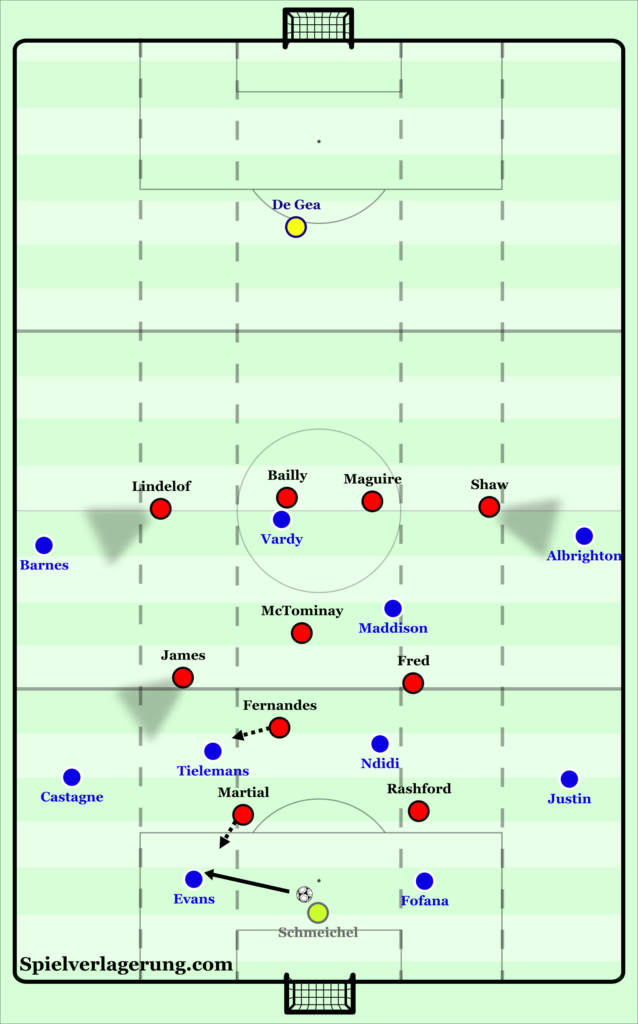
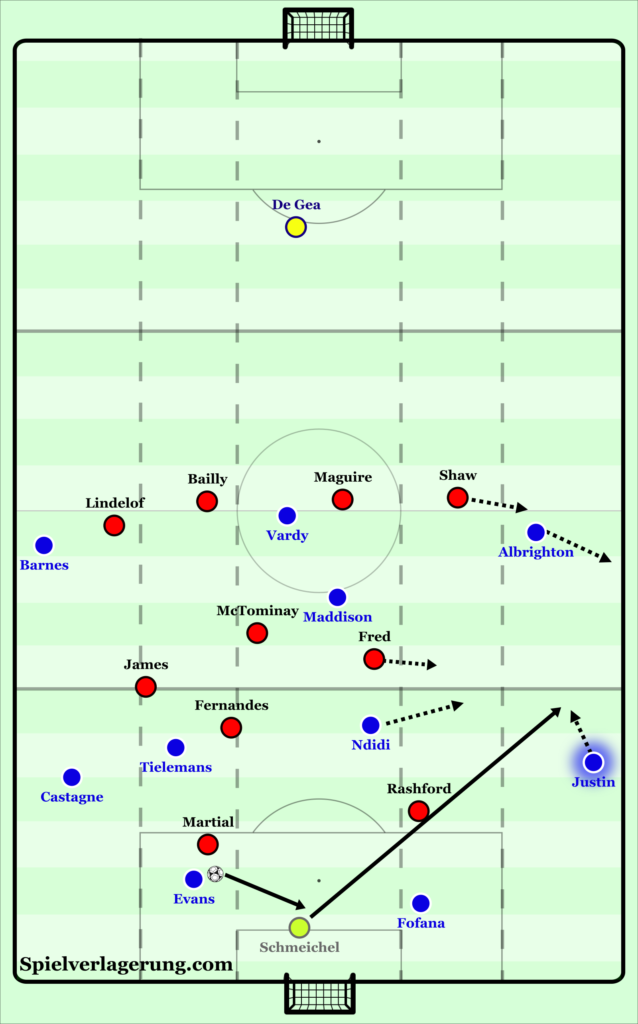
Despite the large amount of success this strategy has provoked (most potently against narrow midfields & those who attempt to front-screen full-backs), Rodgers has adjusted it to be more effective against certain opponents who attempt to stifle it by limiting the outlet to full-backs using wider players to restrict full-backs, whilst also allowing the Foxes to take advantage of the weaknesses within opposition strategies. This can be presented using the example of Chelsea, who pressed using a 4-2-3-1 when out of possession, which can be perceived as an attempt by Lampard to restrict the escape route via full-backs that Leicester use so often.
As Presented in the graphic below, with possession slightly higher than the prior example due to play originating from a regain of possession as opposed to goal-kick, Chelsea set-up in a 4-2-3-1 to press with Abraham and Havertz operating as a pivot with the nearest player pressing whichever centre-back has possession respectively and the other dropping in to cover the space left centrally. Further beyond this, Pulisic and Hudson-Odoi are positioned within the half-space in anticipation of pressing in-out whilst curving their run to force play back inside upon the trigger of any passes into Justin/Castagne. The remaining central-midfield duo remain as a screen to any movement beyond whilst also retaining a position to press, should players drop into the space in front of them. The rationale was clearly to restrict Leicester’s ability to escape via full-backs in the widest lane, and force them into mistakes or into direct play from which to they can utilise as a trigger to regain, given that the press was largely passive and there are no evident traps in certain spaces/areas.
However, Leicester had made their own adjustments and there were subtle changes to individual positioning detail to counter-act this strategy. Justin and Castagne had moved higher and wider and taken up positions horizontally on line with Pulisic/Hudson-Odoi, allowing them to receive on the back foot with the sufficient space to step and break past this initial “3-1” press or alternatively to move higher beyond their respective markers should Fofana/Evans have secure possession and/or step in as shown below. This had two potential benefits, it stretched Chelsea wingers and forced them into a decision of whether to stay tucked in, which would prevent passes into the higher Tielemans/Maddison or whether to stay wider to restrict passes into Justin/Castagne which would potentially open up passing lanes to play into Maddison/Tielemans. Either of which provide an outlet for Leicester to combine and play out of the defensive third.
Furthermore, Leicester’s changes also impacted central-midfield, with Rodgers opting for a single-pivot that subsequently allowed Tielemans to push higher into a more conventional 4-3-3 alongside Maddison with each positioned in the right and left half-space respectively. As a result, it created a midfield 2v2 beyond Ndidi which in theory isn’t too advantageous, yet when considering the inability of Mount to track Maddison (to be explored below the next graphic) it becomes a pertinent problem for Chelsea and one for Leicester to exploit. Once more, Barnes/Albrighton/Vardy remain in higher positions in order to pin back James/Chilwell and Silva/Rudiger respectively, though Albrighton/Barnes tucked in slightly more than the prior example against Manchester United due to Justin/Castagne moving wider to ensure they remained on differing vertical lines.
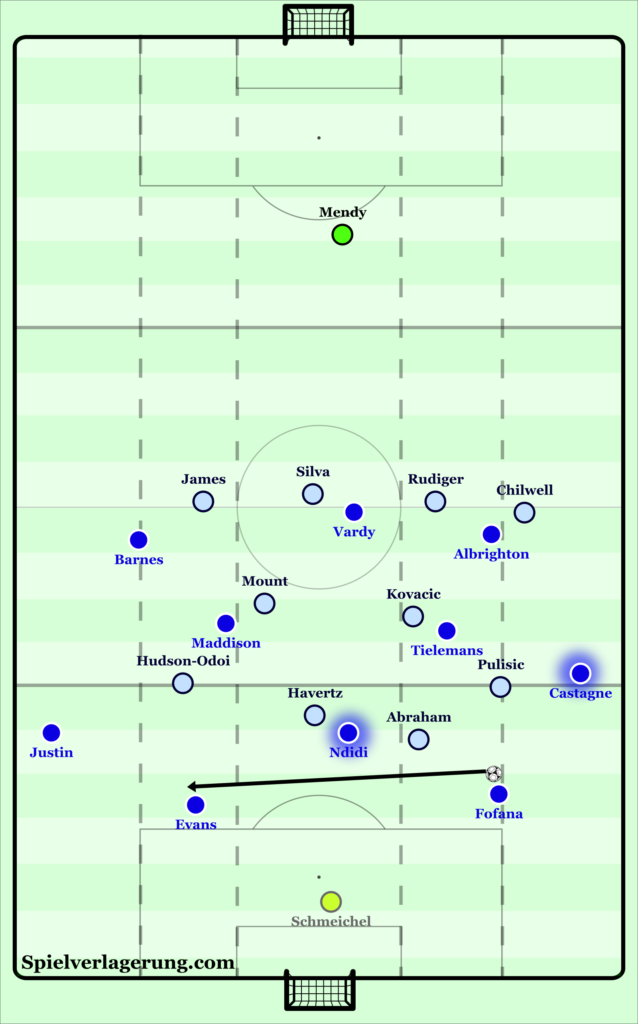
As a consequence of the above changes, Leicester re-instated the potential to escape the press in wide areas due to the adjustment in full-back positioning whilst also creating an added ability to attempt to exploit Chelsea’s deeper midfield inability to defend effectively, yet the focus within the below example remains upon the main adaptation of switching to a single-pivot. The conceptual benefits can be perceived within the first graphic below, with the heightened position of Tielemans/Maddison creating vacant space within deeper half-spaces for the duo to drop into and link-up if they desire, which if tracked could simply allow them bounce possession back on the front foot whilst it could open up a secondary outcome more direct passing lanes into Barnes/Vardy/Albrighton. Yet, if not followed they could simply receive with an open body orientation and attempt to play forwards to break Chelsea’s midfield line. In addition to this, if either were able to exploit the inefficiencies in either Kovacic or Mount and move beyond them (and outside of a cover shadow), it would enable them to either receive directly beyond Chelsea’s midfield line or become an extra man wherever needed, as happens below.
As Evans receives from Fofana and plays into Justin in the first graphic, Maddison has moved to be in a position on the blind-side of Mount whilst also continuously retaining an open body orientation and scanning to receive, enabling that if played to in this moment that he can break not only Chelsea’s press but also their midfield line. It must be highlighted that Mount’s inability to either front-screen and remain with Maddison is poor – yet is caused by the fluidity of Leicester’s approach. Meanwhile, Justin has also dropped into a deeper position to receive, creating space ahead of him in a wider area. Away from possession, Tielemans remains on the opposite side of play, to isolate Kovacic and ensure both of Chelsea’s deeper midfielders are in direct 1v1s.
As such, with Maddison on the blind-side and seemingly dis-marking himself from Mount, as soon as Justin receives he is able to play around Hudson-Odoi and into Maddison who has created the space to move, becoming the extra man and receiving in the widest lane. This subsequently allows Ndidi to step into the vacated midfield space and allows Leicester to create a 3v2/4v3 in wide areas (excluding/including Barnes), from which they follow-up by Maddison playing a quick one-two combination with Barnes to progress beyond James and set an attack upon Chelsea’s last line.
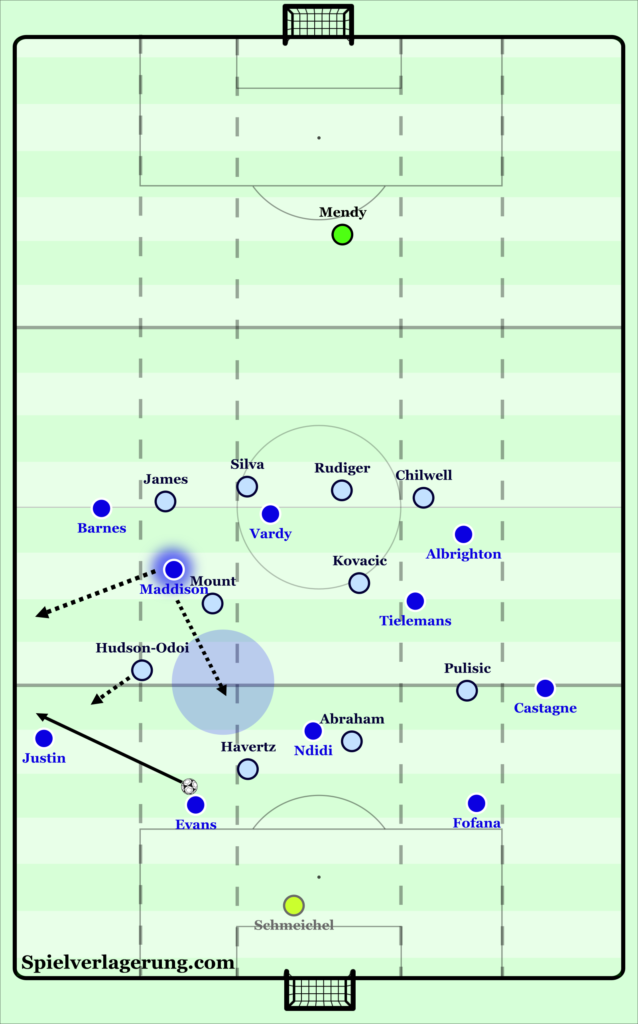
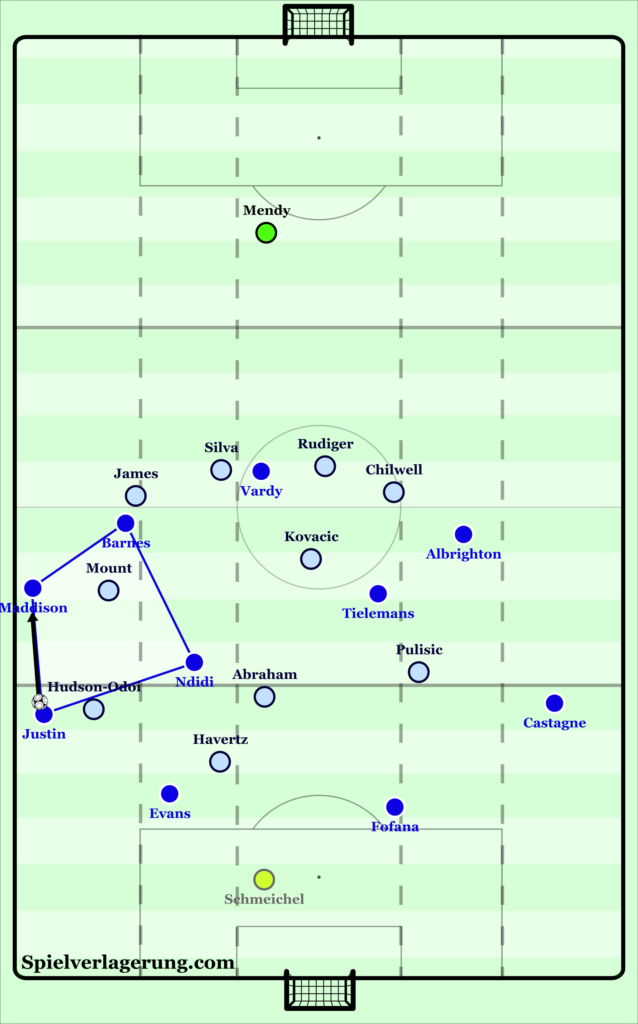
However, as much as the above strategies are viable against various high-pressing approaches, they become somewhat obsolete when tasked against an opposition who opt rather to sit in a medium block and refuse to engage upon Leicester’s back line, as the challenge is now to penetrate a compact midfield block rather than pick apart a press. It is within this, that Leicester have further alterations to positively influence their build-up.
As shown in the first graphic below, when tasked with situations akin to this against Manchester United’s mid-block, with Fofana in possession as the far-side centre-back, Tielemans dropped in as a false full-back to attempt to draw the opposition out of their compact structure and play forwards to penetrate the midfield line (Tielemans dropping 5/10 yards deeper than Ndidi in build-up is a regular occurrence to receive in vacant space unpressured and attempt to play forwards, Ndidi does this vice-versa but less frequently). As a result of Tielemans movement, Rashford was split between remaining deeper with Castagne (which if done may have allowed Tielemans to step forward and penetrate centrally into Maddison who was “hiding” on the blind-side and between both McTominay and Fred) or to engage with Tielemans, of which he did the latter. Therefore, as Tielemans received and Rashford engaged with a half-press (which was wholly ineffective as it neither affected the quality of Tielemans pass in the first instance or front-screened to restrict Castagne receiving in the second), Castagne could push higher beyond Rashford and receive to break United’s compact structure.
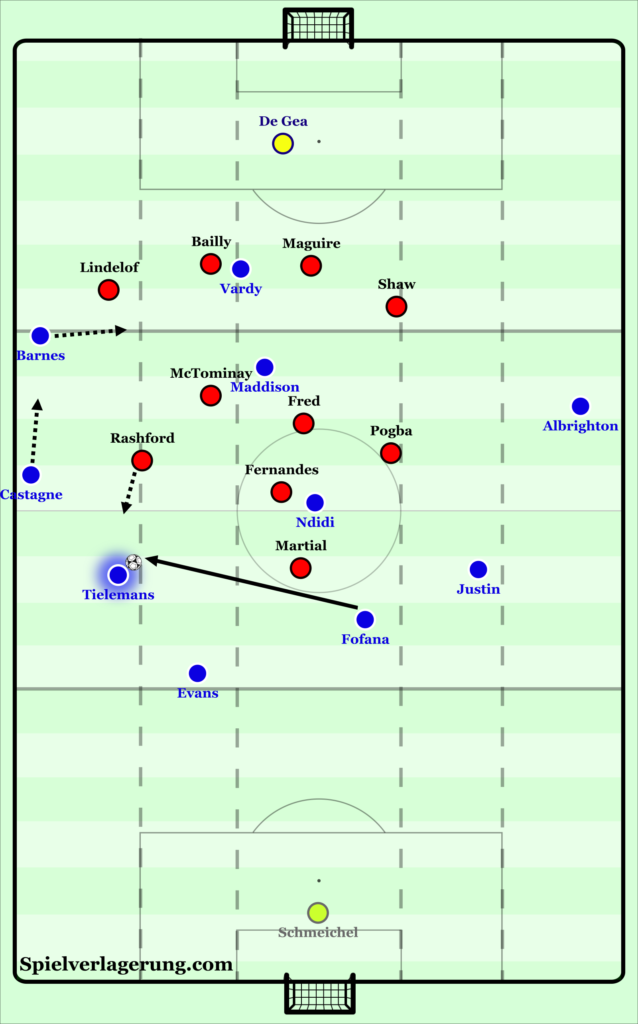
This allowed Tielemans to play beyond the half-press from Rashford and into the now higher positioned Castagne to break United’s midfield-block, whilst Leicester had also managed to isolate Lindelof in a 2v1 to penetrate their last line as well. As Castagne moved in the widest lane, it subsequently pushed Barnes narrower and onto the inside of Lindelof, a position which posed Lindelof issues as he was unable to press both Castagne and restrict Barnes blind-side movement. To exploit this, upon the trigger of Castagne receiving, Barnes made an explosive run beyond the back shoulder of Lindelof to prevent his ability to track the run due to his forward facing perception upon Castagne, from which Castagne duly played Barnes into the space beyond and successfully completed a penetration of all of United’s units within two passes. Although, the role of Vardy in helping to isolate Lindelof must not be diminished, despite being away from possession his positioning between Bailly and Maguire centrally ensured that Bailly would not be drawn into covering the aforementioned run by Barnes (as if he did, it would leave a direct passing lane for Castagne to play into Vardy in a more dangerous central area). Once again, this displays a subtle variation that allows Leicester to retain success in build-up even against more compact approaches.
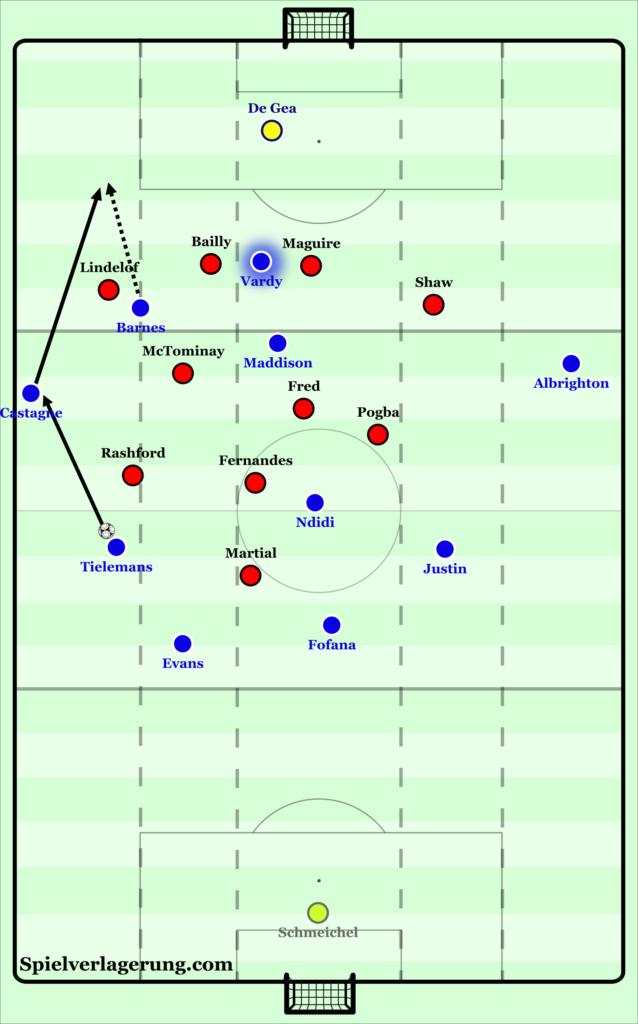
Focused Attacking Strategies in Wide Areas
Once Leicester progress into the opposition’s half, a substantial volume of their attacking prowess is based upon the variation of combinations used in wide areas that allow them to progress. The first to consider is the use of underlaps, an example of the underlap can be demonstrated again against Manchester United’s back-four in the graphics below, following playing beyond their initial press and switching possession to exploit space.
Upon the trigger of Maddison’s pass into Albrighton who is positioned in the widest lane to stretch United’s defensive unit horizontally and make space for an underlap, Justin makes a direct run in-between Shaw/Maguire and beyond the back shoulder of Shaw to ensure he remains on the blind-side, ensuring that a successful pass from Albrighton would result in him receiving possession in the half-space. As the pass is played, Shaw engages upon Albrighton which creates the necessary space for Justin to exploit and receive in the half-space beyond Shaw. If Shaw did not engage, the underlap would have not been a possibility and rather would have kept United in a compact shape, yet he did possibly due to the depth of Justin when the initial pass from Maddison was played. Whilst it must also be appreciated that the narrow position of Tielemans, Ndidi and to an extent Maddison (in the example) centrally, creates further opportunities for these underlaps to occur, with such a narrow central position they draw pressure centrally and thus away from the wide areas which allows Justin in this instance to attack without Rashford being in a close enough proximity to recover and track him (as Rashford has to tuck in centrally to remain compact and prevent penetration “through” United’s midfield line).
Therefore, upon Albrighton receiving and due to the above considerations, he is able to play beyond Shaw and into Justin who is now in the half-space with the opportunity to either drive at Maguire or deliver into Vardy. He chooses the latter and once again, Vardy remained in-between centre-backs, yet on this occasion Maguire engaged due to the scenario being higher up the pitch. This allowed a delivery into Vardy, who checked his run as the delivery was made to create the space to run across Bailly and meet the cross as it arrived, with a better final delivery possibly leading to a goal-scoring outcome.
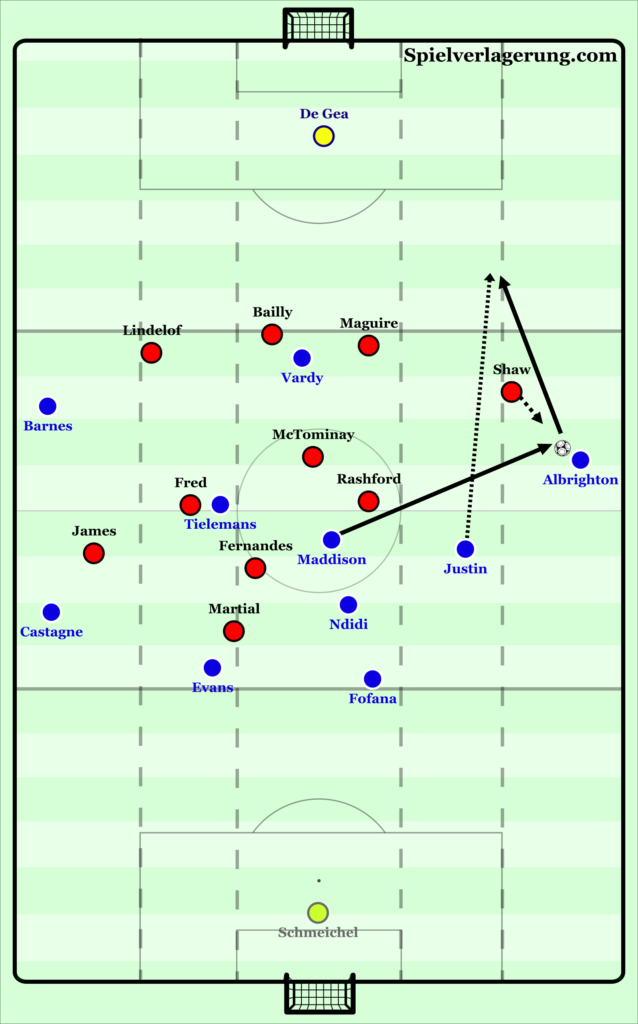
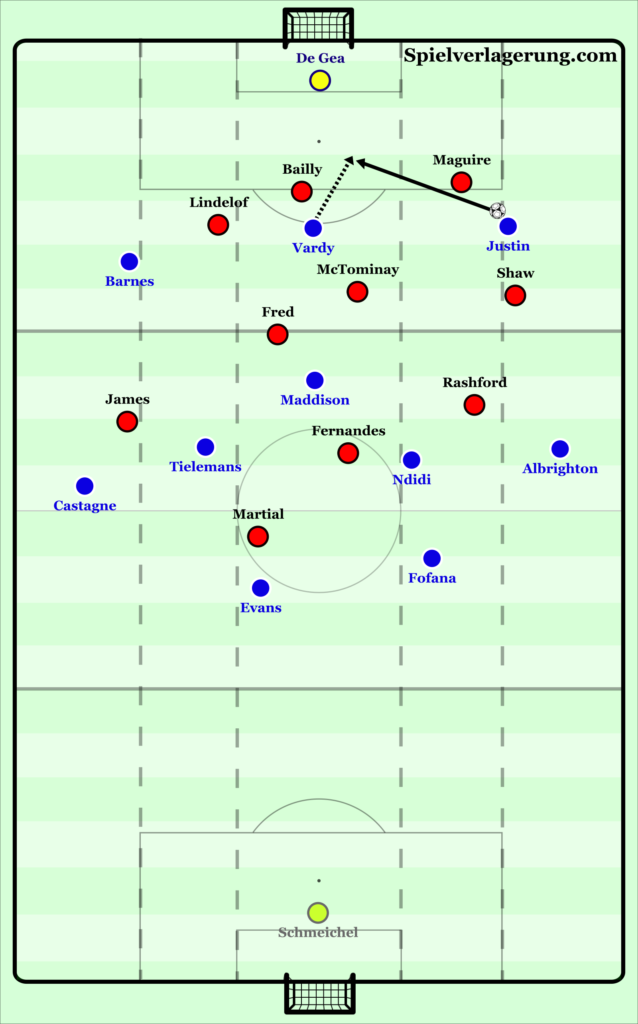
Although, this raises a relevant consideration of why Leicester use the underlap so often particularly on the right with Albrighton often staying in the widest lane, compared to the overlap which is only sparingly used in comparison when Barnes drives infield and presents either Castagne/Justin (whichever plays at left-back as they have fluctuated between each side of the back-four) the opportunity to go around him. The conceptual benefits of the underlap compared to the overlap have been explored below.
Firstly considering the underlap, it allows the ball player an increased level of perception/awareness and thus can enable better decisions to be made in possession, something that is integral given the importance of ball retention possession-based approaches such as Leicester’s. With the wide player in possession in the widest lane, there are an increased numbers of opportunities available to him, whilst he has the increased width of perception to observe the changing scenarios and thus pick the most suitable option. The priority, would be to exploit the underlap to play beyond the opposition’s full-back into the half-space, whilst there are alternative opportunities to play a square ball and use the underlap as a 3rd man combination, cross directly into the area or play backwards to retain and recycle possession, all with less immediate pressure upon the ball-player. Compare this with the overlap, as the wide player has to drive inside to create space in the outside lane for the overlapping player and often position himself within the half-space it restricts the width of his awareness, as naturally the overlapping players will run past the ball-player’s blind-side and put him at a disadvantage. This is combined with the increased pressure that may be immediate upon the ball-player in a more central area as well as the limited opportunities to play backwards due to increased congestion and potential pressure from behind. Whilst appreciating that there is still the potential for crossing opportunities and the overlap itself, the variety of potential outcomes limit the overlap in this scenario and provide the underlap as a more advantageous option.
Secondly, based on the premise of success in each approach, the underlap creates direct penetration into a more dangerous area of the pitch with successful underlaps often causing penetration into the half-space (dependent upon the depth/weight of the pass). This provides an increased benefit for teams that use this approach, by enabling them to receive in a position that is more dangerous and in closer proximity to the goal for a potential shot/cut-back, in Leicester’s case this could be to either Vardy/Maddison within the penalty area or cut-back to Tielemans/Ndidi on the edge of the box. In contrast, the overlap only allows penetration into the widest lane which is a less dangerous area of the pitch and limits the receiving player to deliver from a wider area. It could be argued that there is the potential for the overlapping player to progress into the half-space once they have received, yet this depends on the proviso of the opposition full-back not recovering in time to limit their advances, something that very rarely occurs.
Thirdly, the underlap affects the defender’s ability to defend effectively within the underload in a much more impactful way. The underlap, due to the blind-side nature of the underlapping player’s run ensures that the defender cannot focus on both players within the 2v1 at all times, as such it puts the attacking team at an a advantage, as the defender will have to choose between attempting to engage with the ball-player or to restrict the pass into the underlapping player, allowing them to exploit the defender in this moment. If the defender chooses to focus upon his forward facing perception and the ball-player, it presents the opportunity for the underlapping player to receive in more space as the defender is drawn towards the ball which leaves more space beyond him.
However, if the defender chooses to follow the run and surrender the immediate space in front of him it presents the ball-player the opportunity to drive inwards and deliver from a narrower area. Whereas, the overlap allows the defender to remain in a position to observe both the ball-player and the overlapping run, as alluded to previously it rather disadvantages the ball-player as the overlapping run is made on their blind-side. In this situation, the defender is able to delay his decision as to whether to engage with the ball-player or to follow the overlapping run, as he can remain compact until possession is played to the overlapping player and upon this trigger travel to restrict the progression of the receiving player and reduce their impact upon the game.
It would be naïve to suggest the overlap didn’t have its benefits, for instance on the left-hand side where Barnes will at times attempt to drive in to combine or shoot, it provides a useful opportunity to attempt to play beyond the opposition’s full-back. However, from a conceptual perspective the underlap seems to be much more valuable and be the reason why Leicester use it prominently.
A further combination used in Leicester’s wide attacking play is utilising the trigger of front foot bounce passes to play beyond opposition blocks into 3rd man runners. The below example depicts how useful these are, particularly to draw in pressure to one area of the pitch before proceeding to exploit space created in another as a direct consequence, using the variation of a wide-midfielder in the half-space and a full-back in the widest lane.
As in the graphic below, with Evans in possession and stepping past the passive press from Martial, Barnes used this as an opportunity to drop a yard deeper to receive on the front foot. As the ball is played, Lindelof engages with Barnes to remain “in contact” aiming to force possession back as a minimum to prevent progression, or to affect the quality of the return pass as a more advantageous outcome that could be used as a trigger for players ahead to press. If he didn’t engage, it would allow Barnes the opportunity to receive on the half-turn and drive at United’s back-line, whilst if he engaged prior to the ball being played it presents Tielemans the opportunity to miss out the combination and play directly over into Castagne (both eventualities regularly occur in Leicester’s play). The nearby James/McTominay on either side of Barnes are unable to press effectively upon Barnes in this situation as Barnes is positioned beyond them and they are too far away to attempt an interception, though he does gain both their lines of sight (there is potential to suggest they could have pressed from in-front as a double-press, but opted not to as one can perceive that this wasn’t a tactical strategy employed by United). As Barnes receives, he has successfully drawn in the pressure from not only Lindelof but also obtained the attention of both James and McTominay before bouncing possession back to the slightly deeper Tielemans. Therefore, directly as a result of Barnes movement, Tielemans and Castagne have been brought into the situation in a more effective fashion, with both of them now devoid from pressure that may have previously been applied by McTominay/James.
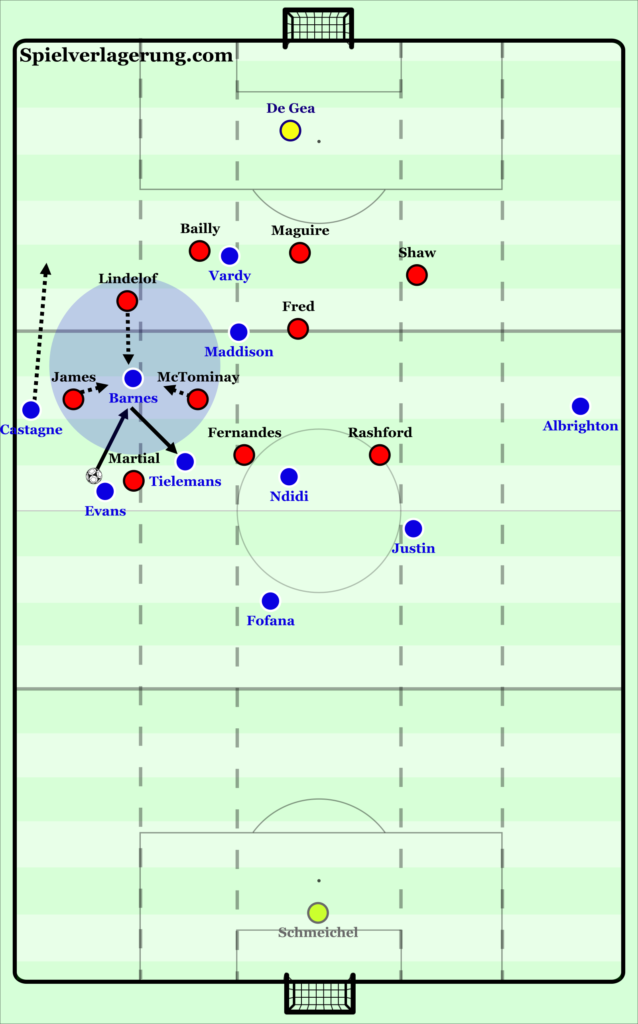
As a consequence, this allows Tielemans to receive unpressured and play into the 3rd man run that has been made by Castagne beyond United’s midfield line as well as Lindelof himself. The details of Castagne’s run are also integral and are underpinned by the initial details on the pass from Evans as well as the foresight of Barnes’ receiving context. As Evans pass is slightly weaker in weight it draws Barnes in, combined with Barnes receiving under pressure, this provides the cognitive trigger for Castagne to make the run prior to Barnes receiving as the only conceivable option is to bounce possession backwards which is the pre-cursor to play beyond into the 3rd man run. If Evans played a heavier pass, it would have limited the ability to play the same pattern as it would have inhibited Barnes ability to play off one-touch and decrease the likelihood of Tielemans being able to play off one-touch (either by forcing him to control before playing which would likely restrict the pass into Castagne as James would have recovered or affecting the quality of his pass and perhaps limiting the quality of the attack).
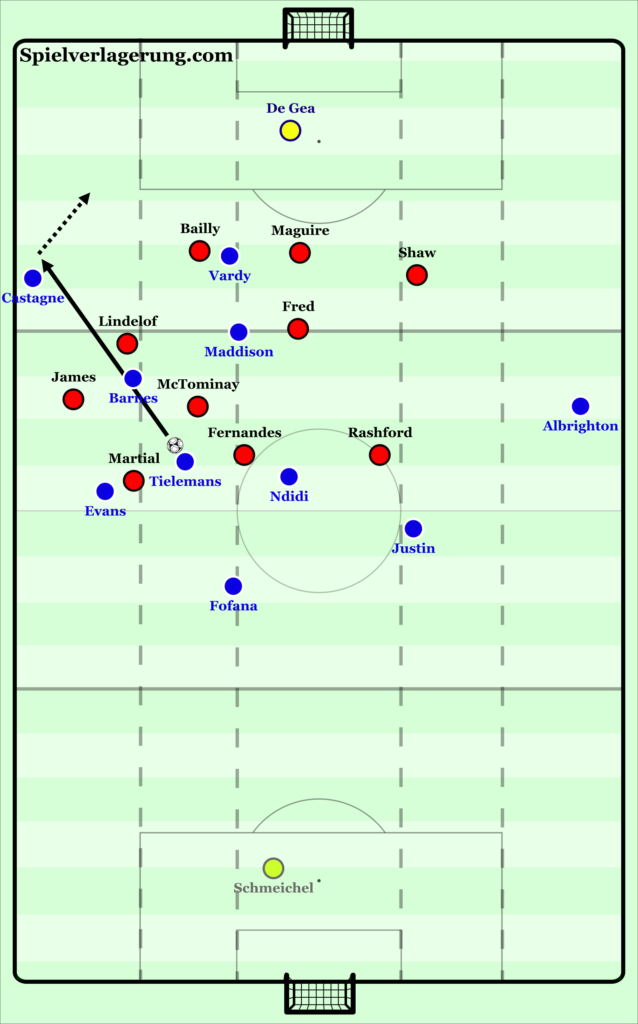
To adapt and enhance these strategies further, Leicester have employed a flexible approach to ensure that their “wide triangles” (consisting of the attacking-midfielder, full-back and winger on each respective side) can move fluidly, ensuring they can continue to penetrate using quick one-touch combinations even when facing under-loaded or congested situations.
Using the conceptual example of a 4-4-2 medium-block, applied by teams such as Southampton (which is systematically doubled up in wide areas, whilst this concept is easily transferrable across to other formations that double up in wide areas), the influence and outcomes of these rotations can be perceived, with the full-back and attacking-midfielder making differing movements to disrupt the opposition and create possible follow-up actions to penetrate the opposition’s last line.
As displayed in the first graphic, upon the full-back (Justin/Castagne) playing into the winger (Barnes/Albrighton) in the widest lane, this acts as a trigger for the attacking-midfielder (Maddison) to make a run between the opposition’s near-side full-back and centre-back. As a consequence of this run, due to the inability of the full-back to track it due to his engagement upon the winger (if he did track the run it would provide the opportunity for the winger to simply drive inside), this means that either the opposition’s near-side central-midfielder or near-side centre-back must follow the run. In this scenario, we have assumed that the centre-back follows the run given his increased ability to anticipate play with the action unfolding ahead of him (though the following actions would still be available even if near-side central-midfielder followed it). Meanwhile, at the same time, Leicester’s full-back makes a direct run into the space vacated by the attacking-midfielder with the intention of receiving possession (if the opposition CM hasn’t followed the run of the attacking-midfielder as below, it is important that Leicester’s full-back remains ball-side of this man to retain the ensuing overload).
Therefore, this allows the winger to play a quick return pass into the newly positioned full-back on the periphery of the half-space. In doing this, Leicester have created a temporary 3v2 against the opposition’s centre-backs with the attacking-midfielder drawing one wide and the striker (Vardy) fixating the other in a central position ensuring that he cannot travel across and cover (if the striker drifted over this would allow the opposite centre-back to narrow off and diminish the potency of Leicester’s attack in the process). As such, this poses two potential follow-up actions. The first would be to play between the centre-backs and into the run of the attacking-midfielder (who could run across his marker or behind him – either of which would be effective), enabling him to be in a position to square across to the striker or shoot himself. Whilst the second, would be attempting a more difficult pass into the striker and create a direct opportunity to score, though this option may become increasingly available if the opposite centre-back came across to reduce the horizontal gap between himself and the other centre-back, allowing a pass to be played across him and into the striker.
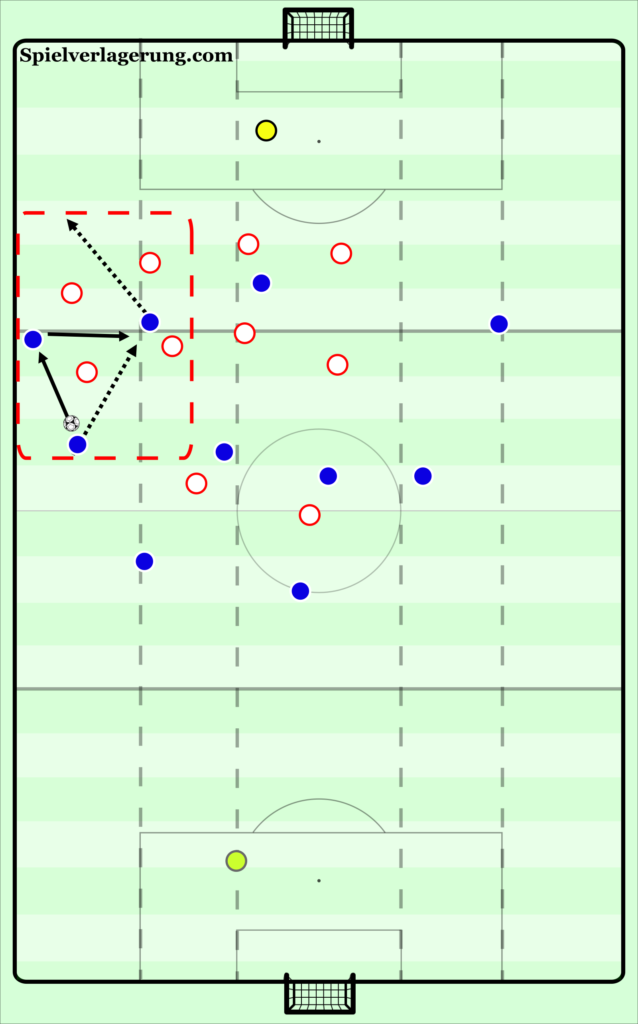
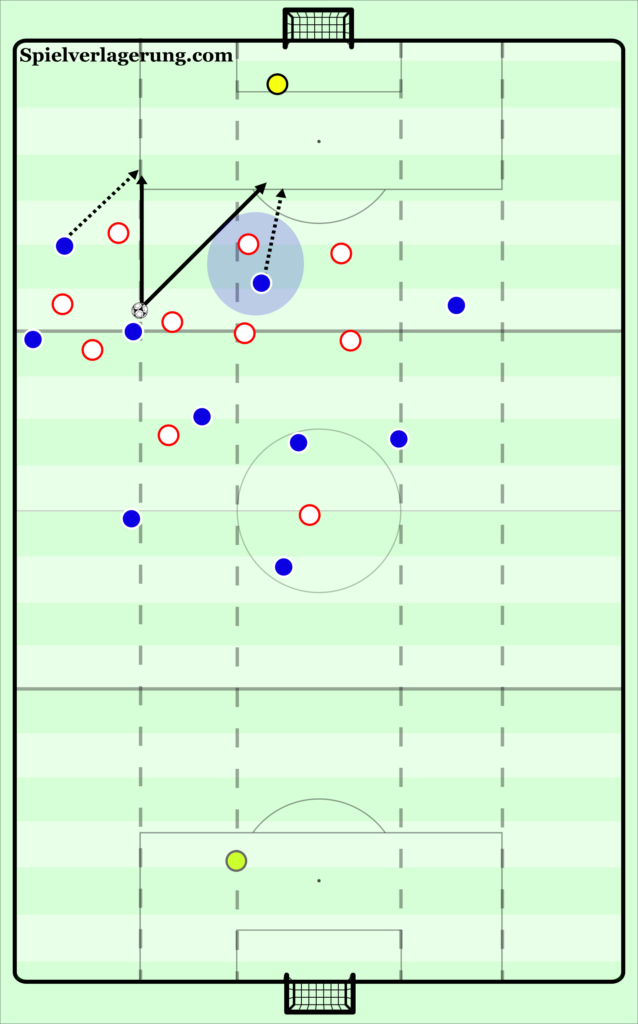
However, despite the high efficacy of Leicester’s attacking strategies they have been stifled by some opposition strategies, namely Newcastle’s extremely compact and defensive 5-4-1 which nullified the effectiveness of Leicester’s attacks in wide areas particularly.
As displayed below, in the 1st half against Newcastle, wide areas were locked off with Newcastle’s wide-midfielders shaping their body to ensure that play was forced outside and wide players within the half-space were restricted by cover shadows. Furthermore, this isolated Barnes with a surrounding box of pressure from all angles if he was played to in the half-space. If in the instance below, Castagne decided to continue into wide areas, it would lead to a 1v2 and ultimately a strong likelihood of losing possession with Almiron able to double upon with Castagne. Consequently, this forced play inside to Ndidi/Tielemans upon which Newcastle pressed as a trigger to restrict time/opportunities to penetrate, this subsequently forced mistakes from which Newcastle could regain or as proved more frequent force Leicester back or sideways and restrict their progression. As a result, the only real penetrative outlet was when possession was fed through to Maddison who already retains the freedom to roam wherever the space is available to develop and progress Leicester’s play, which was limited by the 2v1 front-screening by the Longstaff brothers and even Joelinton at times such as the below.
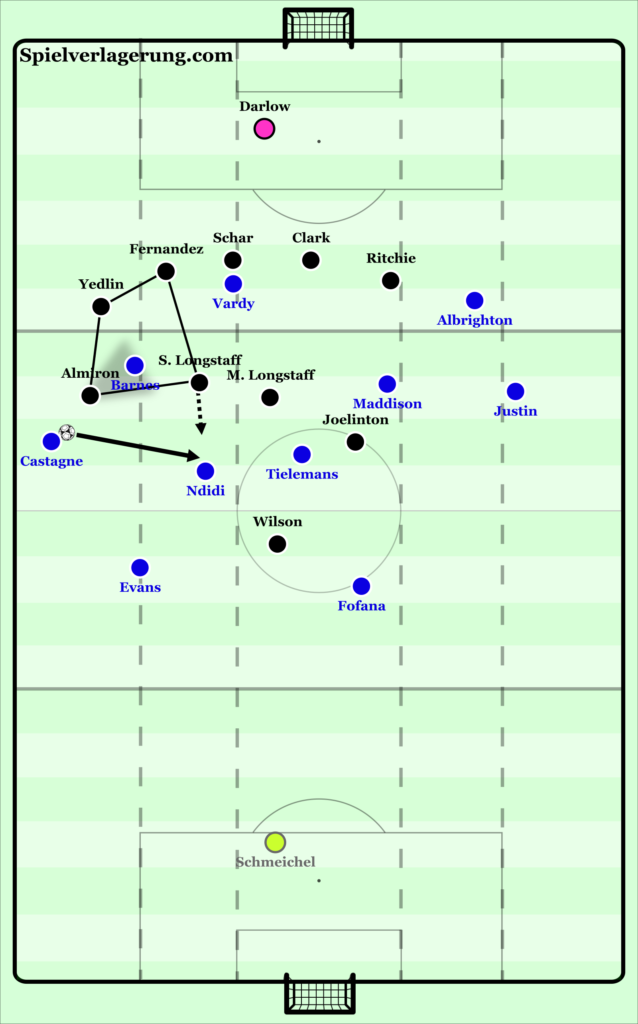
Therefore, to avoid this and maintain penetration Rodgers adapted Leicester’s play in the 2nd half, the front-four were provided an extended fluidity and one which is evident when Leicester play against opposition who sit in deeper defensive blocks (the recent game against Everton is another good example, who used a deep 4-4-2 medium/low block). In particular, Barnes was given the freedom to roam beyond Newcastle’s midfield line and receive centrally to avoid congested areas of the pitch and subsequently being under-loaded (in the process creating an asymmetrical structure, one that allowed Leicester to exploit the overloaded central area in the first instance, but also creating the option to switch play to Castagne as a secondary option on the vacant left-hand side with space created by Barnes preceding movement). Vardy/Albrighton also have the flexibility to rotate in these scenarios, Vardy mostly stays central to fixate opposition defenders, though when he does rotate it is predominantly on a positional basis with Barnes or Maddison. Whereas Albrighton is the most structured of the front-four but will alter between positioning in the widest lane or half-space dependent upon the right-back’s position to ensure they are always on opposite horizontal/vertical lines for ease of combination play.
As shown, rather than remaining within a structured position, Barnes roamed over to a more central position when possession was secure and in the process created the ability to penetrate centrally with Newcastle’s central-midfielders subject to a 3v2 with Tielemans in possession ahead of them. This created a dilemma for Shelvey/Longstaff, if they engaged with Tielemans then he would simply play beyond them, whilst if they remained front-screening Maddison/Barnes it would allow Tielemans to progress (from Leicester’s perspective, scenarios like this are simply a waiting game before the opportunity to penetrate presents itself). The eventuality was that they did neither, Longstaff half-pressed Tielemans and this allowed Maddison to move wider to escape the cover shadow, creating a passing lane to receive beyond the midfield line. The importance of Barnes’ freedom must be highlighted, if he wasn’t present beyond Shelvey and thus taking his influence away from the situation, this would free Shelvey to engage with Tielemans and Longstaff to cover Maddison more effectively (or vice-versa), whilst Barnes would have been out of the situation completely in an isolated left-midfield position and Newcastle would have likely continued to frustrate.
Upon Maddison receiving, he resides in this blind-side position where he thrives so much, able to receive on the half-turn beyond the opposition’s midfield and provide the direct opportunity to thread through to Vardy or be more conservative in possession, his success in this aspect making him such a dangerous threat between the defensive and midfield lines. These aspects are represented below, the most progressive option would be threading through to Vardy, who has made a run across the central centre-back and beyond the near-side centre-backs blind-side to remain untracked and create some space for himself upon a successful pass beyond this player. Whilst another eventuality arises to play into the 3rd man run of Justin at right-back, which would ensure Leicester retain possession whilst maintaining attacking momentum (the second option was taken given Leicester were 2-0 up at the time). This provides an extension to Leicester’s strengths in wide areas and alludes to the fluid nature within Leicester’s attacking play, providing a strategy for Barnes (in addition to Maddison who already does so) to roam freely and create overloads against the opposition wherever necessary.
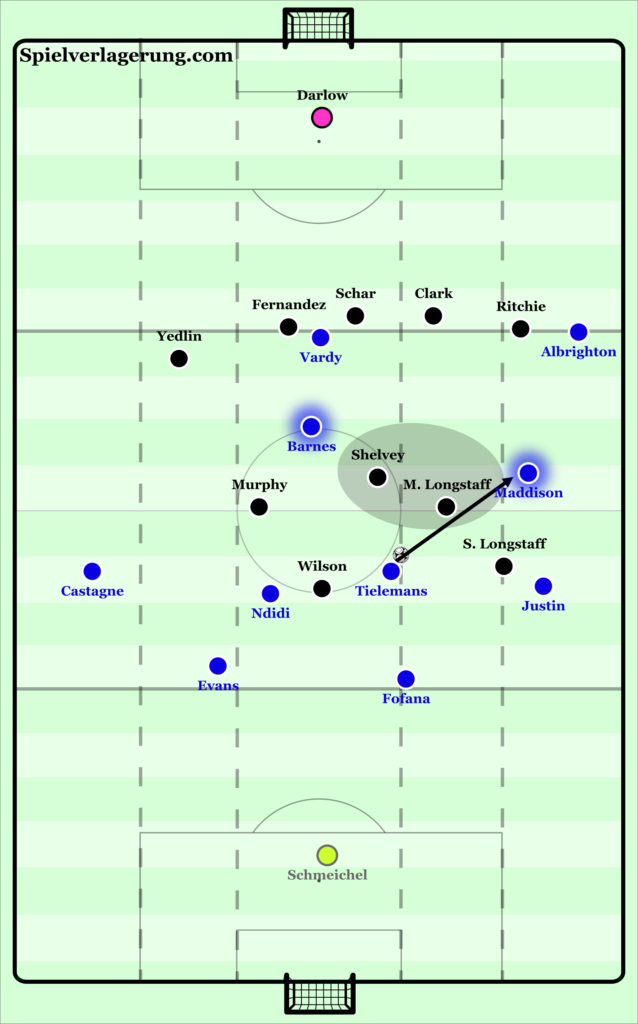
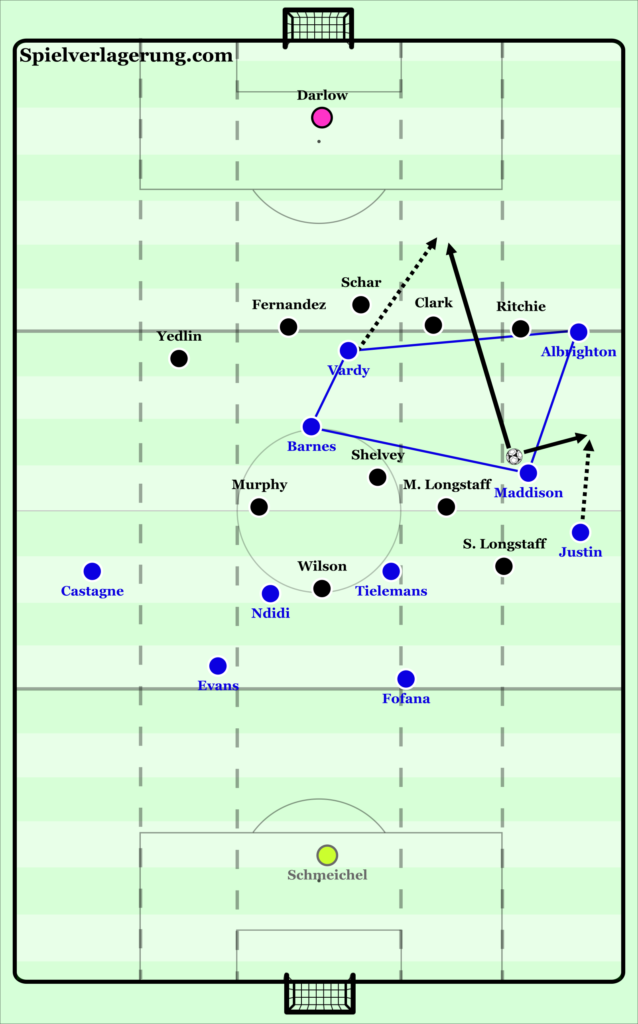
Pressing Approaches
Switching the focus onto Leicester’s approach out of possession, their approach to pressing is aggressive with flexible roles to regain possession primarily in wide areas, but also in central areas when deemed most useful using the same system.
The first example of this can be shown against Chelsea below, with this flexibility allowing them to set pressing traps in wide areas, preventing Chelsea from playing centrally into their three central-midfielders as well as Pulisic/Abraham/Hudson-Odoi who moved freely and aimed to receive in the gaps beyond this. Upon Mendy having possession, Vardy is the main pressor whilst Albrighton positions himself half-way between Silva and Chilwell, with the distance beyond him to Chilwell “inviting” the direct clip into him. Beyond this, Maddison has dropped deeper to ensure Leicester are matched up 3v3 against Chelsea’s central-midfield whilst Barnes is dropped deeper onto James (this is as Mendy is shaping up to play left & possession has just come from his side). In the eventuality that Chelsea ignore the opportunity to clip into Chilwell, Leicester are equally matched centrally and on the left, with Vardy able to press from behind to retain a numerical advantage. This leaves Leicester’s back-line with a 4v3 against Chelsea’s front three that they can easily manage and be aware of. As a result of this and as expected, Mendy clips directly into Chilwell.
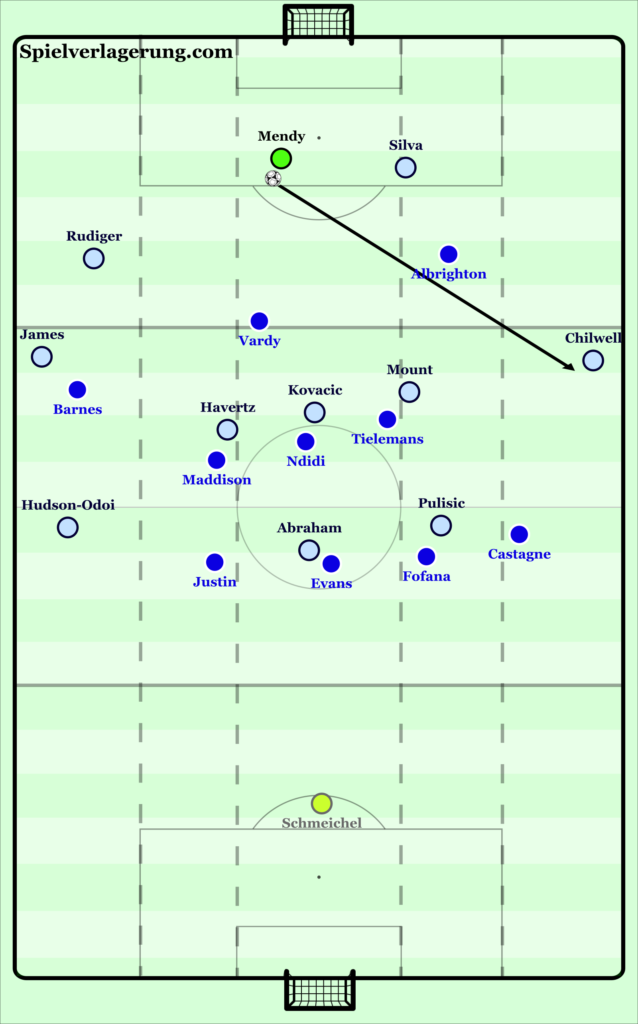
However, this is used to draw Chelsea into a false sense of security, with Leicester using this as a trap to retrieve possession in wide areas by suffocating the space available Chilwell and restricting his passing options by overloading the left-side of the pitch from all directions. As Chilwell receives, Albrighton makes a recovery run whilst preventing the pass back to Silva by pressing aggressively from behind and ensuring he blocks the potential passing lane back to him. Likewise, Vardy also moves into a position to cover centrally and restrict the pass into Kovacic who has dropped slightly deeper than possession, ensuring that Chilwell’s only option is to drive forwards (if he turned back he would be met by pressure from Albrighton and provide Leicester an immediate opportunity to regain high up the pitch). In addition to this, Tielemans presses from the right of Chilwell in order to extend the application of pressure upon him from inside and encourages Chilwell to continue travelling wide, whilst the potential for the supporting Havertz to receive inside the pitch is prevented by a combination of Tielemans keeping him in his cover-shadow (this may just be a convenient coincidence) and Ndidi pushing across to apply pressure directly upon him. In the event that this 1v2 against Havertz was bypassed and played beyond, Maddison is locked onto Mount centrally to restrict his ability to receive, leaving Chilwell no options yet again. As such, Chilwell progresses towards Pulisic who is marked by the in-contact Castagne and covered by Fofana who has shifted across to support the press. Therefore, this presents Chelsea with a 3v5 underload and one which allows Leicester to regain possession upon the trigger of any attempted pass by Chilwell or a mistake whilst he is in possession in this area, whilst demonstrating a pressing trap that Leicester have used extremely well during this season.
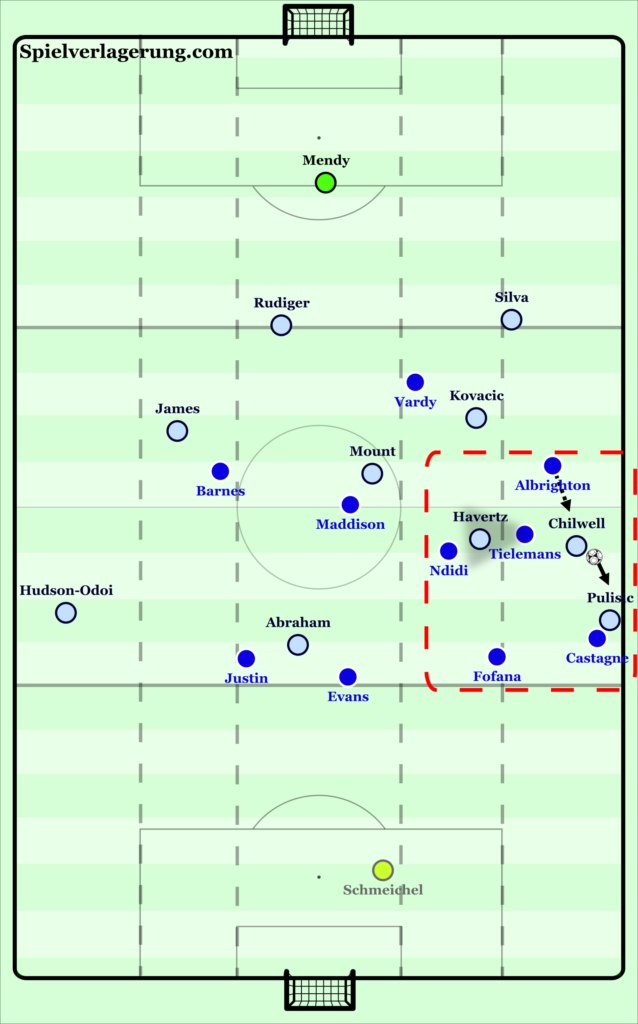
Leicester can also manipulate their system to force play into central areas in game situations when they have an advantage here, as shown against Newcastle’s 5-4-1 where Leicester wanted to prevent play into wing-backs and rather into central areas where Leicester had an extra man.
As shown below using the pass into outside centre-backs as a trigger to engage (if the central centre-back had possession, Vardy forced play out to either one to cause this scenario), rather than inviting play wide, Barnes curves his pressing run to restrict the pass beyond into Yedlin whilst applying significant pressure to Fernandez himself. In parallel, Vardy positions himself on the near-side of Schar as to prevent him from receiving by ensuring he remains in his cover shadow leaving Fernandez only two options – either attempt to play forwards or retain back via Darlow. If play went backwards, Vardy pressed Darlow which forced play long and gave Leicester the opportunity to regain via aerial duel, something that can be perceived as partial success with a lack of height in Newcastle’s attack (Wilson as a lone-striker). Furthermore, Albrighton has tucked into the centre of the pitch to combine with Maddison in marking both Longstaff’s and pressure them if they are played to. Deeper than this, Ndidi and Tielemans are in a position to either front-screen or mark Almiron/Joelinton who took up varied positions both beyond them to receive and dropping in to link-up play, whilst beyond this Evans/Fofana can track any movement beyond the midfield line if it is too far away from Tielemans/Ndidi for them to affect play. In essence, this creates a significantly overloaded and congested area for Leicester to regain from, which a perceived central 4v3 advantage.
Therefore, upon any pass by made Fernandez, as shown in the second graphic below Leicester are in a position to once again press on any pass into central areas with an intention to regain possession and create their own attacking transition. In addition to this, any player than occupies the space between Tielemans/Ndidi also opens up the opportunity for Leicester to double-press and assert this overload even further, allowing Leicester upon winning possession, to immediately slide Vardy through with vast gaps between all of Newcastle’s back three. In practice however, the eventualities were not as ideal as this, after recognising this overload Newcastle looked to increasingly miss out Leicester’s midfield box and go more direct with play restricting the extent of their combinations in central areas, however the adaptation of Leicester’s pressing still serves to demonstrate the flexibility within their approach.
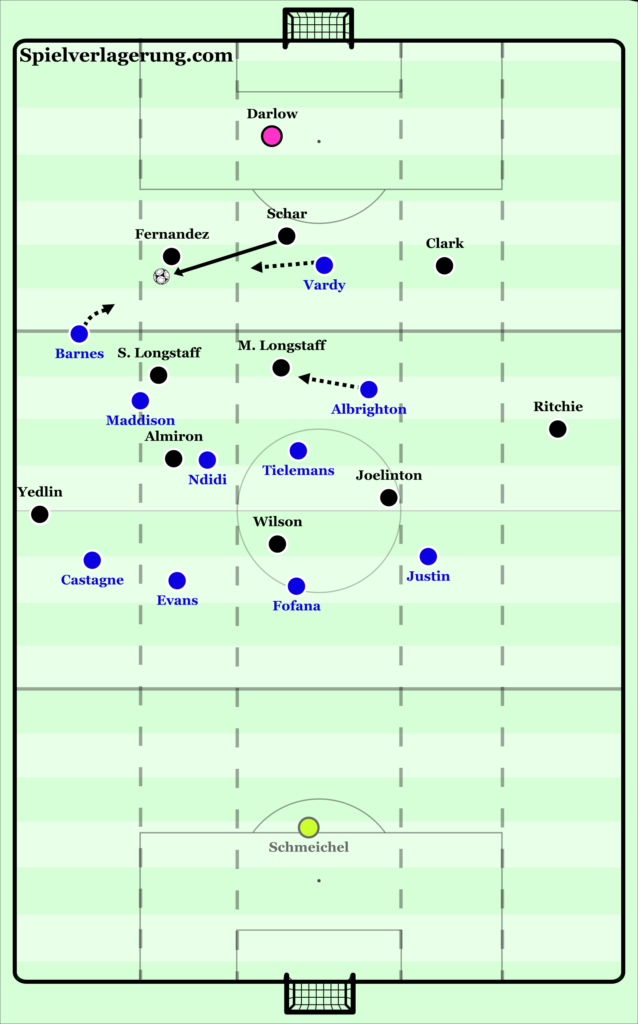
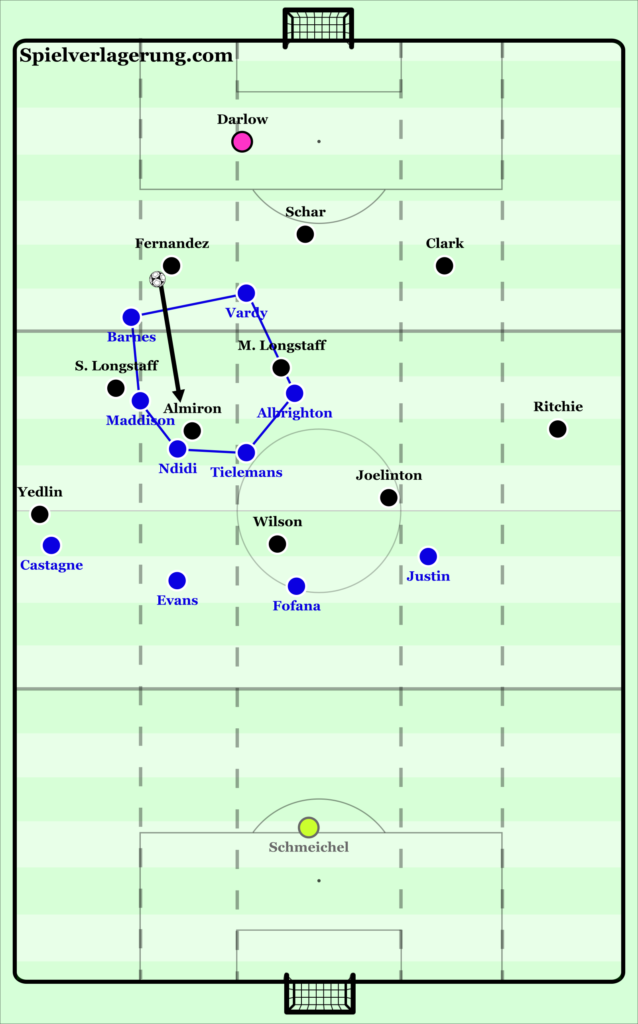
However, not all of Leicester’s pressing strategies have been as effective as those above, with perceived vulnerabilities portrayed against Manchester United, subsequently allowing United to escape from their defensive third.
As illustrated in the first graphic below, with very slight adaptations to their press, Leicester aimed to force United into wide pressing traps and force regains of possession. Upon Bailly having possession, Vardy presses from an angle that prevents a pass sideways to Maguire by keeping him in his cover-shadow and maintaining a position close enough to De Gea to subsequently force a pass out to Lindelof. As demonstrated previously, Barnes presses with an angle and body orientation attempting to cut off central passes and force Lindelof into playing possession into the aforementioned wide pressing traps with Castagne locked-on to James beyond him. In central areas, Maddison occupies a man-man orientation upon McTominay whilst Albrighton has narrowed off to affect Fred in the same manner. In deeper areas, the double-pivot of Tielemans/Ndidi maintain an initial 1v2 against Fernandes, whilst Martial occupies the space between the Leicester’s defensive and midfield line and seems of no immediate danger. The conceivable and predicted outcome should be that Leicester can once again force a mistake via these wide pressing traps and regain possession. However, upon the trigger of this pass into Lindelof, a simple rotation between Fernandes/Martial causes disruption to Leicester’s structured press and combined with an ineffective press/engagement from Barnes allowed United to escape.
As a consequence and shown in the second graphic, Barnes failed to completely restrict the possibility of Lindelof being able to cut back into the pitch and attempt to play inside, with his pressing run not arched enough to block off central areas preventing this eventuality and not intense enough to impose sufficient pressure to force Lindelof into playing wider earlier whilst Martial’s rotation had not been completed. As such, Lindelof was able to shift the ball across his body and onto his left foot which opened up the opportunity to play centrally. If Barnes’ press maintained maximum effectiveness and restricted this ability to cut inside, the ability for United to break the press would have been prevented in the first instance. This allowed Martial, following his rotation with Fernandes from the blind-side of Ndidi/Tielemans with detail on him speeding up upon passing Ndidi/Tielemans enabling him to generate space, to receive in-between Leicester’s midfield box and quickly play out to Shaw who is in vast amounts of space due to Albrighton’s narrow positioning, before pressure from Tielemans arrives. If Tielemans was able to apply pressure to Martial upon receiving, this may have allowed Leicester to regain their advantage with him surrounded from all directions, yet Martial’s speed and blind-side starting position ensured Tielemans was unable to track him instantly. This consequently resulted in a 2v1 against Justin from which United were able to continue past Leicester’s last-line following combinations from Shaw/Rashford. This highlights a potential exploit for Leicester’s opponents, with a perceived vulnerability to blind-side rotations from beyond Tielemans/Ndidi effective in breaking their press, yet this is only a snapshot of inefficiency in Leicester’s approach within a pressing system that largely remains extremely effective.
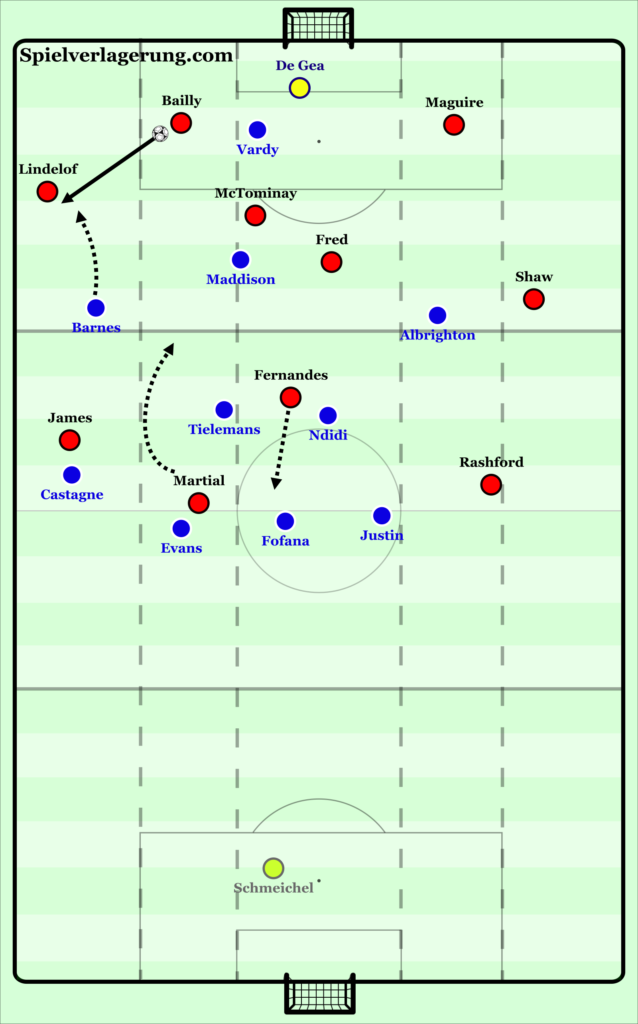
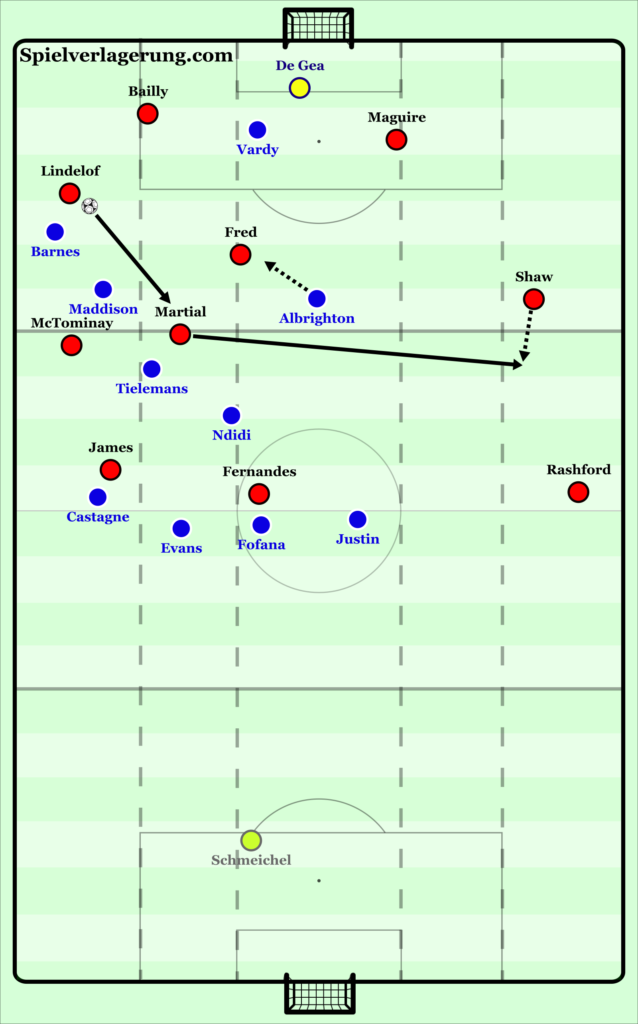
Conclusion
It is clear that Brendan Rodgers has developed an intelligent Leicester side, capable of adapting their approaches to remain effective against any opposition. Both in and out of possession, Leicester have strategies to quickly change and exploit weaknesses in a wide range of opposing strategies, from deep lying back 5’s to high presses whilst also maintaining a catalogue of attacking combinations to maximise their attacking potency, all of this combined which has no doubt allowed them to be successful and ultimately seen them comfortably inhabit a top four position. However, the success of this strategy (and perhaps Leicester more widely) resides upon having key players fit to maximise this system, with Ndidi primarily but also Vardy acting as lynchpins to its success which is certainly something to keep an eye on during the Foxes Premier League run-in as they look to secure a Champions League spot for next season.
1 Kommentar Alle anzeigen
JG February 17, 2021 um 5:28 pm
Excellent article. I learned so much from this. May I recommend next time to break up the paragraphs more with reposting the images, just with highlighting different components of the scenario. I found it very hard to keep scrolling down and back up to reference the image during the long written descriptions